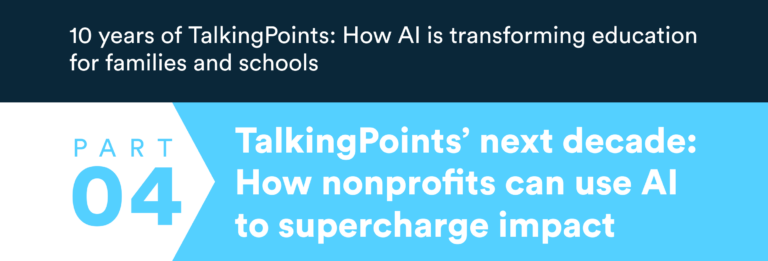By Kevin Fosnacht, Ph.D.
As our CEO and Founder Heejae Lim recently said in her TED Talk:
“A parent is a child’s first teacher and children spend 80% of their waking hours outside the classroom. Research says that for a student to do well in school, a family’s engagement is more important than a family’s wealth. In fact, their engagement has two times the impact on student outcomes! Families ARE the game-changer.”
Decades of research have shown that family engagement has a significant impact on student outcomes. Here at TalkingPoints, we have plenty of evidence that there’s a relationship between using TalkingPoints and improving student outcomes. But, we can now demonstrate — thanks to the release of our new report, Engaging Families Leads to Student Academic Gains and Increased Attendance — that using TalkingPoints caused improved student outcomes.
More specifically, our research demonstrates that schools’ adoption of TalkingPoints leads to higher test scores, course proficiency improvements, and lower absenteeism rates. Overall, students saw higher math test scores by 9 points, a gain that represents 7 months of additional learning for the average student. Read the executive summary of our findings here.
These gains are even more pronounced for traditionally underserved students, including Black students, Latino students, students with disabilities, and English language learners. Most notable were our findings for absenteeism. For Black students, absenteeism rates decreased by 22%. For Latino students, the decrease was 17%. For students with disabilities, the decrease was 25%; and for English Language Learners, the decrease was 18%. The differential results are particularly important as they indicate that groups historically marginalized from K-12 schools benefit the most from using TalkingPoints.
To understand why this matters, it’s helpful to explain the difference between correlation and causation.
Most education research studies demonstrate correlation. One common method in education research is to correlate an intervention with outcomes. In this design, we examine if students who received the intervention have higher outcomes than their peers who did not receive the intervention. If a positive correlation is shown, the intervention likely had an impact, but we can not rule out that students with naturally improved outcomes self-selected into the intervention. For example, students taking AP Calculus likely have higher SAT scores than students enrolled in regular math courses. But, these students likely would have higher scores without taking AP Calculus as students with strong math skills tend to take AP Calculus. This is why researchers commonly say “correlation is not causation.”
In order to make the case that a given intervention directly contributed to the outcome, you have to design a study in a rigorous and specific way.
Our research team — of which I am a member — conducted a quasi-experimental study designed to meet the Every Student Success Act (ESSA) Tier 2 standard of evidence. We looked at a large urban school district that adopted TalkingPoints in 2016 in some schools, and in 2019 and 2020 in other schools. Key to our study was that students did not choose to use TalkingPoints; thus, we avoided the self-selection bias described above.
Given this two-step adoption, we could ask:
- How did the use of TalkingPoints impact student academic outcomes and attendance?
- How did impact on student outcomes vary for different student groups, including groups disaggregated by race and ethnicity, special education status, and English language learner status?
To ensure that the school groups were equivalent, we controlled for individual characteristics, including race and ethnicity, English Learner status, grade, and special education status, as well as school characteristics, including demographics, enrollment, and free and reduced priced lunch rates. We also controlled for school differences that did not change within our study period like Title I status and time differences that impacted all schools. For those curious, we utilized a study design called difference-in-differences.
Now back to the results.
We can now say with a high degree of confidence that using TalkingPoints led to course proficiency improvements, higher test scores, and lower absenteeism rates.
What makes this news so exciting is that TalkingPoints is a rare educational intervention that is inexpensive, can easily scale, and has a meaningful improvement on key student outcomes. This combination of factors is like finding a unicorn in education research.


At TalkingPoints, we have always believed family engagement is a key factor in districts achieving their ambitious goals for their students. Now, we have the proof.
Engaged families matter for student outcomes. Schools must create strong partnerships with families to accelerate learning and wellbeing gains for all students, while closing the gap for the most traditionally underserved students.
And that’s great news for the districts, schools, teachers and families that use our platform.
For more information on this study, download the research brief: Engaging Families Leads to Academic Gains, Increased Student Attendance: How TalkingPoints Improved Student Outcomes in a Large Urban School District



